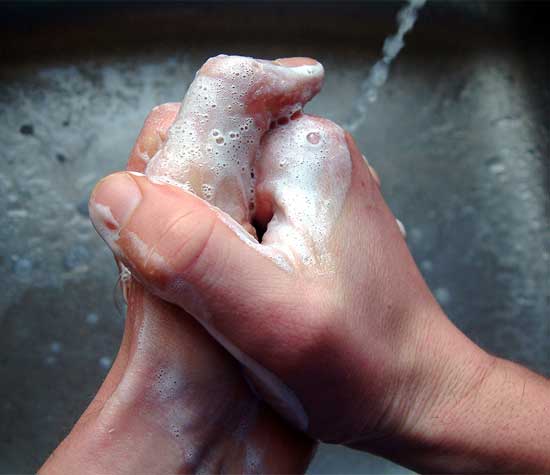For assistance in accessing the training, please contact info@learningcenter.ucsb.edu
Aerosol Transmissible Diseases Training
Aerosol Transmissible Diseases Training
This is required for tissue culture room users who are working with lentiviral vectors that are broadly pseudotyped with the VSV-G glycoprotein.
Course description: This course complies with Cal/OSHA Title 8, Section 5199 ATD training requirements and is required for researchers working with the agents or agents plus procedures given in the regulations: https://www.dir.ca.gov/title8/5199d.html
Examples of agents and agents + procedures that are covered by these regulations:
• Cytomegalovirus, human (viral production, purification, or concentration)
• Epstein-Barr virus (viral production, purification, or concentration)
• Escherichia coli, shiga toxin-producing only (aerosol generation or high splash potential)
• Hantaviruses (serum or tissue from potentially infected rodents, potentially infected tissues, large quantities or high concentrations, cell cultures, experimental rodent studies)
• Measles virus
• Salmonella spp. other than S. typhi (aerosol generation or high splash potential)
• Salmonella typhi (activities with significant potential for aerosol generation, large quantities)
• SARS coronavirus (untreated specimens, cell cultures, experimental animal studies)
• West Nile virus (WNV) (dissection of field-collected dead birds, cultures, experimental animal and vector studies)
The regulations cover replication-defective viral vectors if aerosol exposure to staff could occur, and if the agents are used in a manner or quantity that could result in aerosolization of the agent. Lentiviral vectors that are broadly pseudotyped with the VSV-G glycoprotein are an inhalation hazard and training on aerosol transmissible diseases and additional precautions are required for related work.
The course covers:
• Transmission risk from small particles or droplets containing aerosol transmissible pathogens
• Identification of work requiring aerosol safety procedures
• Use of controls to reduce risk of exposure to aerosol transmissible pathogens and disposal of waste
• Response to an aerosol transmissible pathogen exposure
This is an annual training requirement.
Initial and refresher training is available online.
You will be enrolled to complete the online refresher training in one year after completing the initial.
UC Learning Center search terms: ATD or aerosol
eCourse code: SBHLSF-ATDSTC-ECO
Course duration: 30 minutes
Aerosol Transmissible Diseases Training - Zoonotic
Aerosol Transmissible Diseases - Zoonotic
Presentation Description: This course complies with Cal/OSHA Title 8, Section 5199.1 ATD-Zoonotic training requirements and is required for researchers whose field research presents the risk of exposure given in the regulations: https://www.dir.ca.gov/title8/5199-1.html. Although the regulations are broadly written, the intent is to ensure that a comprehensive injury and illness prevention program is in place. Contact the Biosafety Officer at biosafety@ehs.ucsb.edu to set up training and document the risk assessment.
The course covers:
- Transmission risks from handling wild animals and related materials outside of the lab
- Procedures that require aerosol safety practices and/or respiratory protection
- Disposal of potentially contaminated PPE and waste generated in the field
- Incidents that constitute an exposure and how to respond
This is an annual training requirement.
Initial and refresher training is in person or by video conference.
Course duration: variable; 20-40 minutes
Autoclave Safety Training
Autoclave Safety Training covers the basics on the safe use of autoclaves.
This is a one time training requirement for those tasked with using autoclaves.
Obtain an in-person and hands-on demonstration from the autoclave manager or your lab group supervisor for the autoclave(s) you will use prior to your first use.
Biosafety Training
Course description: Introduction to safe practices for handling biological agents. This course is required prior to working with recombinant or synthetic DNA, infectious materials, infectious animals, human clinical samples and other research-related projects that require BSL-2 or enhanced BSL-2 containment practices.
This course covers:
• The risk assessment process
• Biosafety levels and their best practices
• Engineering and administrative controls, as well Personal Protective Equipment (PPE)
• Disinfection methods and biohazardous waste disposal
• Accidental spill and exposure response
• Shipping and transporting biological materials
This is a one time training requirement for those working with infectious or potentially infectious biological materials.
UC Learning Center search terms: bio or biosafety
eCourse code: SBHLSF-BSFUNDSTC-ECO
Course duration: 60 minutes
Bloodborne Pathogens Training
This is required for tissue culture room users and those working with human or NHP tissues, cells (and excreta).
Course description: This course complies with Cal/OSHA Title 8, Section 5193 BBP training requirements and is for researchers working with human and nonhuman primate tissues.
This course covers:
• The Bloodborne Pathogens Standard
• Epidemiology & Symptoms
• Modes of Transmission
• Exposure Control Plan
• Tasks & Activities
• Methods of Compliance
• PPE Selection
• PPE Decontamination & Disposal
• Hepatitis B Vaccination
• Emergency Procedures
• Exposures
• Post Exposure Evaluation & Follow-up
• Signs and Labels
• Waste Management
• Questions and Answers
This is an annual training requirement.
Initial and refresher training is available online.
You will be enrolled to complete the online refresher training in one year after completing the initial.
UC Learning Center search terms: bbp or bloodborne
eCourse code: UCSB-UCLOL0016-ECO
Course duration: 37 minutes
